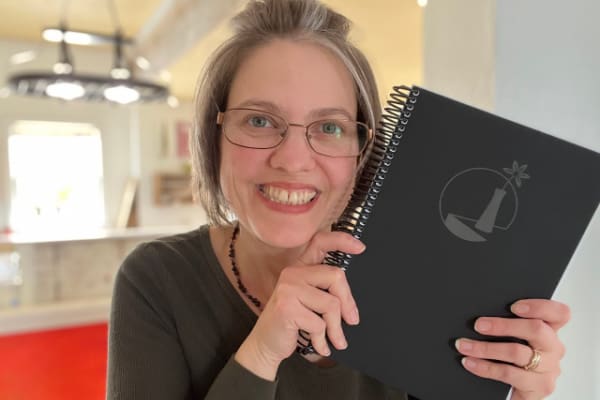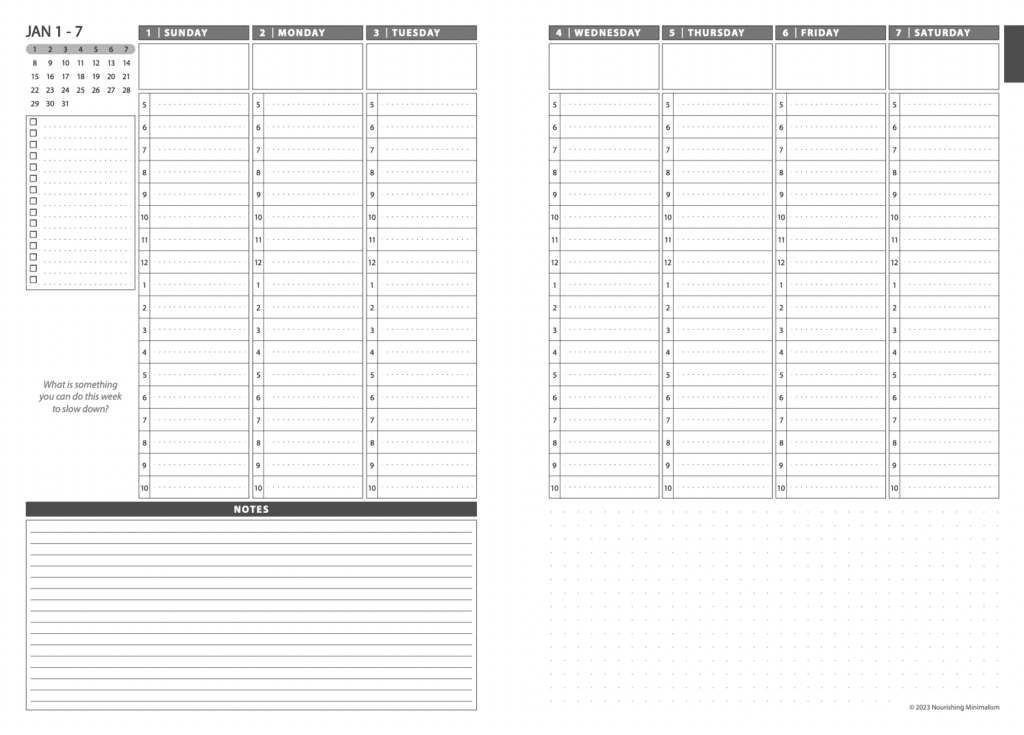Live a more intentional life, 5 ways to use a planner for intentional living.

I have been goal driven most of my life, and though I believe it’s good for us to work toward things, I don’t want goals and productivity to consume my life. I don’t want my “future” to be my focus.
At the same time, I don’t want life to happen to me; I want to have some forethought on how I approach my days. I want to live intentionally and live in the present.
This is why I created the Forethought Planner.
A planner to structure our time without focusing on projects or productivity. This planner has space to write goals and productivity, but it’s not designed where goals and productivity are the focus, so you can use this planner however you wish and what living intentionally means to you: it’s a completely blank slate.
This is a yearly planner with monthly and weekly spreads. The weekly spreads are vertical, and it is a Sunday start.

The hours run from 5 AM to 10 PM and the planner is available in spiral bound with quotes and without.
The optional quotes contain Bible verses, quotes from various Christians, and weekly questions and thoughts to help you pause for a moment.
I designed this to be a blank slate: this planner is meant to serve you and not be a system you need to serve.
1. Consider what you want to be intentional about.
Do you want to invest more time in relationships – spouse, children, family members, friends, church?
Or do you want to have time for being creative, sewing, cooking, painting or perhaps building a business?
Do you want to spend time on hobbies, reading, hiking, gardening, or bird watching?
Or do you want to be more intentional about your spiritual growth? Reading, praying, meditating?
2. Figure out what you can do weekly to support that.
What can you do each week to do more things you want to intentionally include in your life?
Some things might be daily – like blocking off 30 minutes daily to read scripture. And other things might be weekly, like making it a point to have dinner with someone each week.
3. Plan time for no plans.
Downtime is important, and our calendar can fill up so quickly. In his book “Essentialism,” Greg McKeown compared it to our closet; imagine getting rid of clothes that don’t fit and organizing them so everything is easy to get to and we can see exactly what we have. Your closet is beautiful, and Monday morning, you head out the door for the day, pleased that everything went so smoothly because of the time you spent organizing your closet.
But as soon as you are away, people start coming into your house and putting their things in your closet.
Hanging up their shirts, putting sweaters in the drawers – jewelry overflowing on the hooks, your closet is overflowing with everyone else’s stuff when you come home in the evening.
We would be appalled; we don’t need their clothes in our closets!
But how often do we do that with our calendar?
We get everything situated and in order, and then people call and ask us to take on projects and fill our time doing things that help them. And we let the important things to us go to the back burner and think we’ll do them next week instead.
If you want to have some downtime where you have no plans. Schedule it. Saturday afternoon is our relaxation and no-plans day. That means from 2 pm to 8 pm; we do whatever we want as a family. But if someone calls and says, “Hey Rachel, can you do _________ for me on Saturday?” I say no because I have plans to hang out with my husband and kids.
4. Build in flexibility.
It’s important to NOT schedule every minute of every day. If we try to structure everything, we won’t feel like we have breathing room. Often I will only block off my work hours and appointments, then each day, I will fill in the things I need to get done in that time.
This helps because working from home, it’s easy to jump on and respond to emails or try to catch up on things, and without paying attention to how much time we’re spending doing that, we can neglect the things we want to spend our time on.
I want to be around the kids and interact with them after they get home from school. I already know that if I try to work when they’re home, I will be constantly interrupted, then we both get frustrated, which means that I don’t get meaningful time with them, and I make very little if any, progress on work projects.
5. Block out segments of your day for certain activities.
My favorite way to use my planner is with time blocking. Some people like to be consistent with colors, for example, I often use a blue highlighter to represent my work hours and yellow to represent family-related items. But I know some people like to change colors weekly because it makes them pay more attention to their plans.
It’s helpful to block out the things I know I’m already doing: I have set work hours and times for preparing meals and eating together.
Having time blocks for certain things helps me see at a glance what I have going for the day.
I’m excited to announce that this planner is now available on my website!
Click here to checkout the Forethought Planner.
I like a spiral-bound planner because I lay it on my desk so I can see at a glance what I have going on during the week.

Rachel! I love the planner! I can’t wait to get my copy. This is the time of year when all of us planner nerds are excitedly anticipating selecting our new planner for next year. This comes at the right time and appears to have everything I look for and more! Bless you for providing this for us and blessings on everyone who uses it. May 2023 be the year that we all progress forward in our lives with purpose and meaning and a solid foundation in scripture and faith!
Thank you so much, Rachel, for designing a VERTICAL weekly layout!! That is so hard to find in planners currently. And with a little space at the top of each day to note priorities, plus with hourly entries!!
I did find a vertical format one for 2023 after much looking, but I will remember yours for the following year!